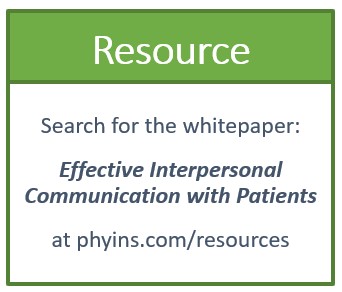 The healthcare setting often involves sensitive and intimate exams that present challenges other businesses don’t face. Misunderstandings can occur in the course of medical practice, and in the post-#MeToo era, something a physician intends as medically appropriate contact can be misconstrued as a sexual advance. Sexual misconduct, or a mere allegation of sexual misconduct, can be a career-ending event for healthcare professionals.
The healthcare setting often involves sensitive and intimate exams that present challenges other businesses don’t face. Misunderstandings can occur in the course of medical practice, and in the post-#MeToo era, something a physician intends as medically appropriate contact can be misconstrued as a sexual advance. Sexual misconduct, or a mere allegation of sexual misconduct, can be a career-ending event for healthcare professionals.
It is difficult to estimate how often physician-patient sexual misconduct takes place, partly because allegations may be delayed. “Patients may not feel comfortable speaking up until years later, after they have had time to process things emotionally,” says Peter Eidenberg, an attorney specializing in medical malpractice defense with Keating Jones Hughes in Portland, Ore.
Another reason is that the term “sexual misconduct” does not always refer to the same type of event. In 2019, the Federation of State Medical Boards (FSMB) found that 251 out of 1638 disciplinary actions against physicians were for “sexual misconduct,” but some of those cases involved colleagues or trainees, not patients.1
“An allegation of misconduct can permanently tarnish your reputation as a physician,” Eidenberg states. “As soon as a question arises about your conduct, especially in the era of social media, it is generally assumed that something inappropriate occurred.”
Recognizing the sensitive nature of the clinical encounter, the AMA Code of Medical Ethics makes it the responsibility of physicians to respect the dignity of their patients by providing “a comfortable and considerate atmosphere for the patient and the physician.” This effort, it goes on to note, should include providing gowns, privacy for undressing, sensitive use of draping for patients and making medical chaperones available.2
In 2020, the American College of Obstetricians and Gynecologists released an opinion recommending that a healthcare chaperone be present in sensitive situations “irrespective of the sex or gender of the person performing the examination.”3
Medical chaperones can provide a level of comfort for patients and may help ensure the best possible experience for patients and physicians alike. In so doing, the likelihood of a sexual misconduct allegation based on a misunderstanding could be greatly reduced. “A claim can go away quickly when we discover a chaperone was present in the room,” Eidenberg says. “Knowing that a reliable witness was present makes it much less likely that a claim or lawsuit will proceed. One of your best protections is to have a chaperone present”
Suffice it to say, having a clear chaperone policy -- that all providers are required to follow-- is an important step for an organization to take to mitigate the risk of sexual misconduct allegations.
Effective implementation of a chaperone policy
Letting patients know the practice has a policy of chaperoning sensitive exams and procedures is important. Ideally, the provider will explain what they will do during the exam or procedure and why. The chaperone should introduce themselves and explain their role.
The chaperones should be trained and well versed in the exam or procedure being done, with training documented in their personnel file. A chaperone should be able to recognize any departure from standard practice.4 As important, the chart notes for the encounter should clearly document the chaperone’s presence, including their name.
Who should be a chaperone?
“Many practices do not have enough RNs to chaperone every sensitive exam,” says Peter Eidenberg, a medical defense attorney at Keating Jones Hughes, P.C. “Medical assistants may be trained as chaperones. So can scribes, who have the advantage of being present in the exam room already. The bottom line is that a trained, experienced chaperone is your best defense.”
A parent or other companion should not be tasked with chaperoning. Having family present is reasonable and appropriate, especially if the patient is a minor. But a patient’s family member cannot be relied on to help a physician’s defense against allegations of misconduct. “You want the other set of eyes in the room to belong to a trained, impartial observer rather than someone who will most likely align themselves with the patient if there is a question about the provider’s care,” Eidenberg says.
It’s recommended that every provider in the organization follow the chaperone policy. However, objections can occur, some of the most common include:
- “I’m a professional. I’m insulted that you would doubt my integrity.”
- “I’ve been doing these exams / procedures alone for years.”
- “Using a chaperone slows me down.”
Waiving or not enforcing the policy for some physicians creates its own risk and potential for liability, Eidenberg says. “Having a policy that a physician does not follow opens the door for a plaintiff’s attorney to assert misconduct. It invites the argument, ‘Why would you violate the chaperone policy unless you intended to abuse the patient?’”
The bottom line: Chaperones mitigate physician risk
Today’s move towards patient empowerment means, in part, that patients are more likely to question what providers are doing. Physicians need to be mindful that the public is less deferential to them than they once were, and that a lawsuit or even allegations of misconduct can profoundly impact their personal and professional lives.
“Once a lawsuit is threatened or filed, the claim is around and in the public eye for at least 18 months to two years,” Eidenberg says. “Regardless of the outcome of a claim or lawsuit, whether favorable or unfavorable, the effects of the allegation may follow the provider the rest of their career. There will always be a question when the provider’s name comes up: did they or didn’t they? Having a chaperone present is one of the most effective tools for mitigating the risk of an allegation and defending a claim of sexual misconduct.”
For risk management best practices on the use of chaperones, the following documents and resources are available on phyins.com for additional information:
- Maintaining Professional Boundaries (0.5 CME)
- Sexual Harassment (Training Talk)
- Preventing and Responding to Patient Allegations of Provider Sexual Misconduct Guidance Document
- Position Statement: Use of Chaperones
- Effective Interpersonal Communication with Patients Resource Guide
References
- Federation of State Medical Boards. Physician sexual misconduct. Report and recommendations of the FSMB workgroup on sexual misconduct. Available at www.fsmb.org. Accessed August 15, 2022.
- American Medical Association. “Use of Chaperones: Code of Medical Ethics Opinion 1.2.4.”
- American College of Obstetricians and Gynecologists. ACOG Committee Opinion No. 796. Sexual misconduct. Obstet Gynecol 2020;135:1. E43-e50.
- American College Health Association, “Best Practices for Sensitive Exams,” October 2019, accessed May 11, 2022, https://www.acha.org/documents/resources/guidelines/ACHA_Best_Practices_for_Sensitive_Exams_October2019.pdf.